Buy Learning Spoken English Ebook on Amazon
Chapter 1: Teaching Your Tongue to Speak English
| Chapter Summary: Speech is controlled in your mind by feedback from your hearing and mouth position as much as it is from your memory. If you want to speak fluent English, it is just as important to retrain your tongue as it is to train your memory. To be effective, however, you must retrain your mind, tongue, and hearing at exactly the same time because they must work together when you speak English.Why have you studied English so long in school without learning to speak fluently? It is because your teachers have tried to train your mind with written exercises without retraining your tongue at the same time. |
If you want to learn to speak English fluently, it will help you reach your goal in less time if you understand how the human mind produces speech.
However, before looking at the way humans produce speech, I want to draw an analogy from machine control because the analogy closely parallels neurological responses in spoken language.
Open-loop machine control
Wikipedia describes an open-loop control system as follows: An open-loop controller, also called a non-feedback controller, is a type of controller which computes its input into a system using only the current state…of the system. A characteristic of the open-loop controller is that it does not use feedback to determine if its input has achieved the desired goal. This means that the system does not observe the output of the processes that it is controlling. Consequently, a true open-loop system cannot correct any errors that it could make.
For example, a sprinkler system, programmed to turn on at set times could be an example of an open-loop system if it does not measure soil moisture as a form of feedback. Even if rain is pouring down on the lawn, the sprinkler system would activate on schedule, wasting water.
Figure 1 shows an open-loop control system.
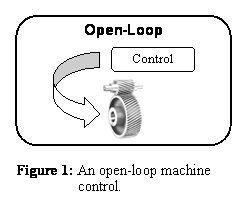
The control may be a simple switch, or it could be a combination of a switch and a timer. Yet, all it can do is turn the machine on. It cannot respond to anything the machine is doing.
Closed-loop machine control
Wikipedia then describes closed-loop control as follows: To avoid the problems of the open-loop controller, control theory introduces feedback. A closed-loop controller uses feedback to control states or outputs of a dynamic system. Its name comes from the information path in the system: process inputs (e.g., voltage applied to a motor) have an effect on the process outputs (e.g., velocity [speed]…of the motor), which is measured with sensors and processed by the controller; the result (the control signal) is used as input to the process, closing the loop.
Wikipedia’s definition of a closed-loop system subsequently becomes too technical to use here. However, as Wikipedia suggests above, a sprinkler incorporating a soil moisture sensor would be a simple closed-loop system. The sprinkler system would have both a timer and a control valve. Either could operate independently, and either could shut the water off, but both would need to be open in order for the sprinkler to operate. The arrangement is shown in Figure 2.
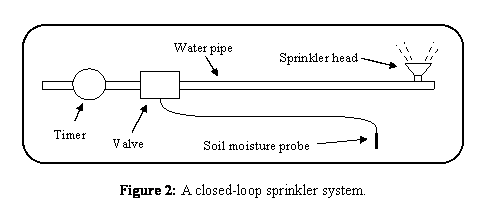
If the soil is already moist, the sprinkler will remain off whether or not the timer is open. When the moisture probe senses dry soil, the valve is opened. However, after the sprinkler is on, if the soil becomes moist enough, the valve will close even if the timer is still open. Thus, the sprinkler uses feedback from its own operation to control itself.
Figure 3 shows a simple closed-loop machine control.
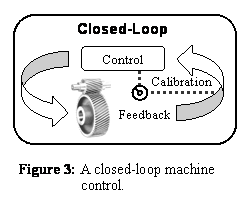
Notice that Figure 3 also shows a calibration function. Irrespective of whether it is a soil moisture sensor on a sprinkler, or a counter on a machine, there must be some way of setting the control so that it will respond in a predetermined way. In a machine application, the calibration function could be a counter which is set so that the machine will produce a certain number of finished parts.
Human speech is a closed-loop system
Human speech is a complex learned skill and is dependent on a number of memory and neurological functions. Speech is a closed-loop system because sensors within the system itself give feedback to the control portion of the system. The control then corrects and coordinates ongoing speech. In this case, the mind is in control of the closed-loop system, the mouth produces the desired product (speech), and auditory feedback from the ears and feedback from the nerve sensors in the mouth allow the mind to coordinate the speech process in real time. [1] Some researchers think human speech is an open-loop system. However, it has been shown that the human brain does many things using both open- and closed-loop control. As suggested in this chapter, spoken English learning would be improved using spoken English study irrespective of whether speech control is open- or closed-loop. [1] [2] All footnotes in this book are inside the text and will be italicized with a beginning and ending number in brackets. [2]
When you speak your own language, your mind stores all of the vocabulary you need. Your mind also controls your tongue, mouth, and breathing. Your hearing is also an important part of the control because your ears hear everything your mouth says. Therefore, what you say next is partially dependent on the vocabulary and other information stored in your mind. But what you say next is also dependent on what your ears are hearing your mouth say and on the feedback that is coming from the nerves in your tongue and mouth.
Because you have spoken your own language all of your life, all of this control is automatic—you do not need to think about it. But when you learn to speak English, you must retrain all of these processes so that they will all work together at the same time. It is not enough to simply put new vocabulary words or grammar rules into your memory. You must retrain your mind to use all of the new sounds your ears will hear, as well as the new movements of your tongue, mouth, and breathing. Yet, since all of these things must happen together for you to speak fluent English, all retraining of your memory, hearing, and the nerves in your mouth must be done simultaneously.
The inter-relationship of these functions is shown in the table below. The meanings of specialized words are given below the table.
| The Organ or Sense | Primary Function(s) | Comments |
| The mind provides: | 1. vocabulary memory 2. partial syntax control 3. feedback coordination 4. calibration by the speaker to give meaning to the sounds. |
The mind is the storage bank for vocabulary. Memory is also involved in structuring syntax. The mind uses both auditory and proprioceptive feedback to monitor and calibrate speech in real time. |
| The mouth and related organs provide: | 1. sound production 2. breath regulation 3. proprioceptive feedback to the mind in real time which regulates pronunciation and provides partial syntax. control. |
The proprioceptive sense is involved in both pronunciation and syntax feedback. It is essential for speech control. |
| Hearing provides: | 1. auditory feedback to the mind in real time. | Auditory and proprioceptive feedback are combined in the mind for essential speech control. |
Proprioceptive. [3] The terms Proprioceptive Method and Feedback Training Method may be used interchangeably in describing this language learning method. An earlier term, Proprio-Kinesthetic Method, was also used for this same language program. I will use the term proprioceptive to describe the neurological process but will call the language learning method the Feedback Training Method.[3]
Human speech would be impossible without the proprioceptive sense. (Proprioceptive refers to the sense within the organism itself which detects or controls the movement and location of the muscles, tendons and joints which are used to create speech.) Our mouth, vocal cords, diaphragm, and lungs incorporate thousands of nerve sensors which the brain uses to control the movement and position of these same organs—the mouth, vocal cords, diaphragm, and lungs. Imagine the complexity of pronouncing even a single word with the need to coordinate the tongue, breath control, and jaw muscles. Now multiply this complexity exponentially as sentences are constructed in rapid succession during normal speech.
Real time. Unlike an open-loop control system, a closed-loop control system monitors feedback and corrects the process as the machine is running. The reciprocal path between the control, the feedback sensors, and the process itself is instantaneous. That is, information is not stored for later use. Rather, it is used instantaneously as the sensors detect it. In this chapter, I use the term “simultaneous” to indicate real time feedback during speech.
Calibration. In human speech, the mind must constantly monitor the feedback information from both the speaker’s own hearing and the proprioceptive senses which enable the mind to control muscles and create the desired sounds. Thus, the speaker is constantly “calibrating” the feedback to control speech. To change a tense, the speaker may change “run” to “ran,” or change the person from “he” to “she,” and so on. These “word” changes are achieved by precise control of the muscles used to produce speech.
We “calibrate” our speech frequently as we talk. This is why we can misuse a word, verb tense, or some other part of the initial sentence, and still make corrections in the remaining words of the sentence so that the listener does not hear our mistake.
Thus, in Figure 4, human speech is represented as the interaction between the mind, the mouth, and its related organs (represented in the figure by the tongue), two feedback systems, and conscious calibration as the speaker constructs each sentence.
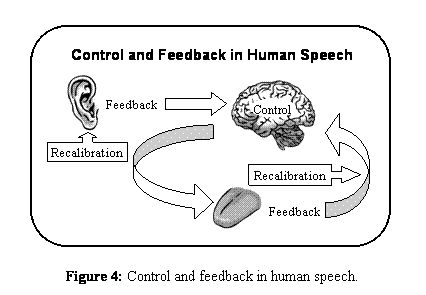
In addition, calibration is continuously taking place within the control center—the mind. However, because it is acting on feedback from hearing and the proprioceptive senses, I am showing calibration as acting on the source of the feedback.
When children learn their mother tongue, their natural ability to hear and mimic adult speech builds complex proprioceptive response patterns. A French-speaking child effortlessly learns to make nasal sounds. An English-speaking child learns to put her tongue between her teeth and make the “th” sound. A Chinese-speaking child learns to mimic the important tones which change the meaning of words. Each of these unique sounds requires learned muscle control within the mouth.
I make no apology for the intricacy of this explanation. The neurological feedback and resulting control of the muscles involved in speech is extremely complex. The mind is involved in a far greater task than simply remembering vocabulary and organizing words into meaningful sentences.
If you are learning English as a new language, all of its unique sounds and syntax must be learned. This is much more than a memory function involving just your mind. Each of these new sound and syntax patterns requires retraining your entire mind, the nerve feedback in your tongue, mouth, and breathing (which is proprioceptive feedback), and the auditory feedback (your sense of hearing).
Even English syntax is dependent on your proprioceptive sense. The statement, “This is a book,” “feels” different to the nerve receptors in your mouth than the question, “Is this a book?” We can certainly understand that memory is involved in the use of correct grammar. Just as important, however, is the observation that proprioceptive feedback demands that a question evoke a different sequence of feedback than a statement. This is why I have identified partial syntax control in Table 1 as being a shared function of both the mind (memory) and the mouth (as a proprioceptive sense).
If you doubt that the proprioceptive sense is an important part of speech, try this experiment. Read two or three sentences written in your own language. Read it entirely in your mind without moving your lips. You may even speed read it. Now read the same sentences “silently” by moving your lips without making any sound. Your mind will respond to the first way of reading as simple information which is primarily a memory function, but will respond to the second way as speech because of the proprioceptive feedback from your mouth.
Did you also notice a difference between the two readings in terms of your mental intensity? The first reading would elicit the mental activity required when you do a written grammar-based English assignment. The second would result in the same kind of mental activity required when you study English using spoken drills. How quickly you learn to speak fluent English will be directly proportional to your mental involvement when you study.
The best way to learn English
Two skill areas must be emphasized if you want to learn to speak English fluently. The first is memory (which is involved in both vocabulary and syntax) and the second is proprioceptive responses (which are involved in both pronunciation and syntax).
You may be able to learn simple vocabulary-related memory skills with equal effectiveness by using either verbal or visual training methods. That is, you may be able to learn pure memory skills equally well with either spoken drills or written exercises.
However, it is impossible for you to retrain your proprioceptive sense without hearing your own voice at full speaking volume. Thus, in my opinion, it is a waste of your time to do written assignments for the purpose of learning spoken English.
Surprisingly, it will take far less time for you to learn both fluent spoken English and excellent English grammar by studying only spoken English first, than it will for you to study written English grammar lessons before you can speak English. This does not mean, however, that grammar is not a necessary part of spoken English instruction. It is impossible to speak English—or any other language—without correct use of its grammar. My statement simply means that the best way to learn English grammar is through spoken English exercises. (See Chapter 3: Grammar and Writing in Spoken English Study.)
Inasmuch as spoken English involves multiple areas of skill working cooperatively in real time, it is mandatory that effective spoken English teaching methods simultaneously train all of these areas of speech. This is shown in Figure 5.
It is the important area of the proprioceptive sense which has been the most overlooked in current grammar-based teaching methodology. When any student over the age of about 12 attempts to learn a spoken language, his or her proprioceptive sense must be consciously retrained for all of the new sounds and syntax.

Furthermore, to properly retrain the proprioceptive sense of the mouth, the combined feedback from the mouth and hearing must be simultaneously processed in the mind. Simply said, the student must speak out loud for optimum spoken language learning.
Without simultaneous involvement of all skill areas of speech, it is impossible for you to effectively retrain your proprioceptive sense in order for you to speak fluent English. Yet, this is exactly what grammar-based English instruction has traditionally done by introducing grammar, listening, writing, and reading as segregated activities. It is not surprising that you have studied English so long in school without learning to speak fluently.
Grammar-based instruction has hindered English learning by segregating individual areas of study. This segregation is represented in Figure 6.
Grammar-based English training has not only isolated proprioceptive training areas so that it prevents simultaneous skill development, it has replaced it with visual memory training by using written assignments. Grammar-based language instruction teaches English as though spoken English was an open-loop system. The result for the student is that gaining English fluency requires far more study time, pronunciation is often faulty, and grammar becomes more difficult to learn.
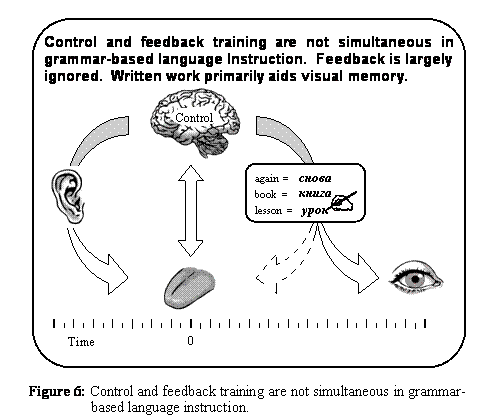
Conclusion
Why has it taken you so long to learn to speak English fluently?
Grammar-based English language instruction teaches as though spoken English is primarily a function of memory. Consequently, grammar-based English lessons emphasize non-verbal (written) studies of grammar, writing, reading, and listening. All of these activities may increase recall memory for written examinations, but they have little benefit in teaching you to speak fluent English.
The only way you can effectively learn spoken English is by using spoken English as the method of instruction. All of your study (including English grammar) should be done by speaking English at full voice volume for the entire study period.
Buy Learning Spoken English Ebook on Amazon | Table of Contents